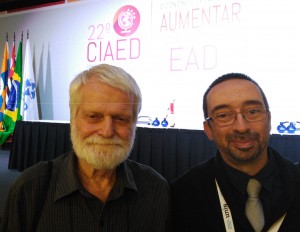ABED Congress. Post #2: Integration of the daily life with LMSs

Current Learning Management Systems (in fact, since the beginning of these tools) try to build a meeting place to provide centralized services to users (i.e. students, teachers, tutors, professors, admin staff, etc.) If we use Sakai, Moodle, Claroline, Blackboard, Canvas or anything else in the market, all of them show similar facilities, like email, ftp, resources, IRC, grades, fora and so on. When the LMS vision started (I designed corporate LMS in 1995, so at least, 20 years ago), this was the right and logical approach to take. By then, Internet services were not focused on Education, but on the technology enhancement. We were all thrilled when we could zipped a file with ARJ writing a long line of cryptic parameters, of when we could download files from a remote server. Not to mention the IRC (chat channels) or the email service, or the news service. As we all know, we call it Internet, but in fact is a bunch of services grouped under a common misconception of what Internet is, to make the concept more digestible for everyone. So, when someone put all these things together, the end user found leverage for learning and teaching.
Nowadays, strictly 20 years after the first “Hello World” web page online, under the WWW service, things have changed. The end user of a learning system is also a regular user of other tools, apps and services that have nothing to do with learning, and that are present on the daily life of everyone. Toys like Whatsapp, Skype, Telegram, WeChat, Hangouts, WordPress, Facebook, Twitter, Instagram, Tinder and others, play a central role of so many people that ignoring them (the tools) is ignoring them (the users).

Modern LMSs should go to the service aggregation model under a middleware paradigm, so that the integration of external tools into the same user-model is smooth and useful
Modern LMSs should go to the service-aggregation model under a middleware paradigm, so that the integration of external tools into the same user-model is smooth and useful. For instance, why to develop a chat when we can integrate Telegram easily. Or why to use an exprofeso developed repository when we can integrate Dropbox or Drive. In doing so, we do not just save coding and development time, but we also integrate the LMS with the daily life of every user. We earn trust and penetration, we melt into the user’s habit, so that the interaction with the educational platform is not something isolated, but another resource to be lived along the other apps. Indeed, integration and aggregation will guide the immediate future of LMSs as a result of a methodology focused on the personalization of the learning experience by the user, either the student, the teacher or the tutor.
